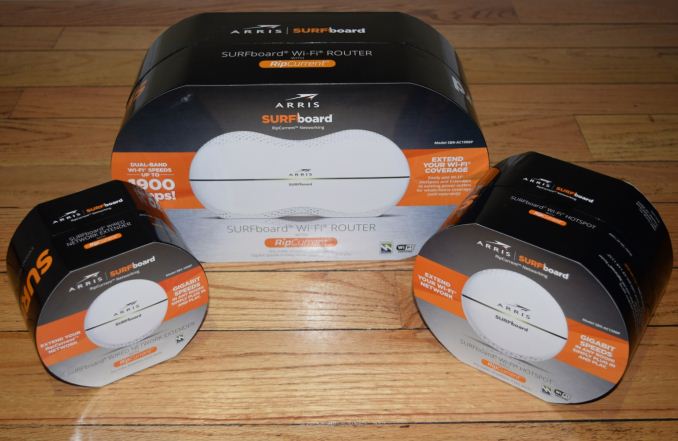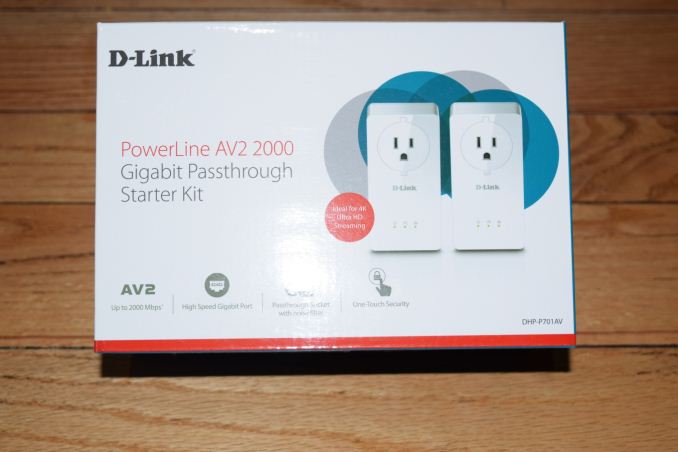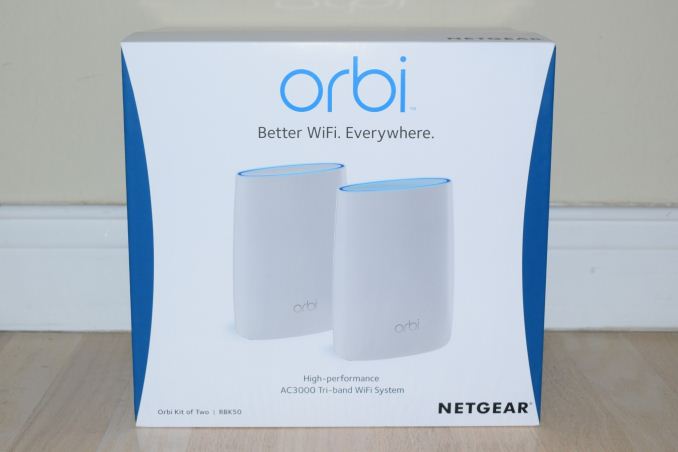Extending Home Networks - A Comparison of G.hn, HomePlug AV2 and Wi-Fi Mesh
by Ganesh T S on December 7, 2016 8:00 AM ESTEvaluation Methodology and Tested Configurations
The benchmarks processed for this article were aimed at determining the effectiveness of kits in extending the reach of the home networks. Therefore, it was an evaluation of the backhaul, rather than performance with client devices themselves.
The ARRIS RipCurrent product lineup is the most comprehensive suite in the market when it comes to hybrid networking. The following products were used in our evaluation:
- ARRIS SURFboard AC1900 Wi-Fi Router with RipCurrent using G.hn (SBR-AC1900P)
- ARRIS SURFboard AC1200 Wi-Fi Hotspot with RipCurrent using G.hn (SBX-AC1200P)
- ARRIS SURFboard Wired Network Extender with RipCurrent using G.hn (SBX-1000P)
Our review of the Comtrend G.hn powerline networking kit compared the first-generation Marvell G.hn chipset with various HomePlug chipsets from Qualcomm Atheros and Broadcom. The highest-end HomePlug AV2 chipset used in that review was the Qualcomm Atheros QCA7500 in the ZyXEL PLA5405 (AV1200-class). This chipset uses only the 0-65MHz band with MIMO, limiting the performance compared to what the HomePlug AV2 specifications allow. HomePlug contacted us with a suggestion to compare against an AV2 2000-class HomePlug AV2 product. D-Link provided us with the DHP-P701AV passthrough kit for this purpose.
In terms of testing wired backhauls using power lines, a comparison of the ARRIS SURFboard router and wired network extender (SBR-AC1900P + SBX-1000P) and the D-Link DHP-P701AV kit can show the effectiveness of G.hn and HomePlug AV2 for extending network reach.
In addition to the hardware made up of standard building blocks (Wi-Fi radios and router SOCs), Qualcomm Atheros's Wi-Fi SON is also a collection of software features. Different customers implement it differently. QCA told us that, as of Q4 2016, Netgear's Orbi is the best example because they use the whole package, while vendors like Luma, Google and eero all use some of the Wi-Fi SON features. Netgear provided us with the Orbi kit (RBK50-100NAS) to test out some of the features of Wi-Fi SON.
A comparison of the ARRIS SURFboard router and Wi-Fi hotspot (SBR-AC1900P + SBX-AC1200P) and the Netgear Orbi presents readers with data to make a decision between Wi-Fi and PLC as backhaul candidates for extending home network reach.
The evaluation of the backhaul in different cases was carried out in a 1800 sq. ft. single-level detached California residence built in the 1970s. The rough floorplan of the house, along with the testing locations, is presented below.
The kits were configured in an isolated network. In the case of routers (the ARRIS SBR-AC1900P and the Netgear Orbi), the setup was quite straightforward with a NUC with an Intel NIC connected to one of the LAN ports. At the other end, we had another NUC with an Intel NIC connected to the wired port of the Wi-Fi hotspot / wired network extender (n the case of the ARRIS kit) or one of the LAN ports on the satellite (in the case of the Netgear Orbi). Since the routers were set up by default to act as DHCP servers, there was no special configuration needed to get IPs allocated to the NUCs at either endpoint. In the case of the D-Link DHP-P701AV, we configured the NUC connected to the adapter at the master location ('M' in red, in the above picture) to act as a DHCP server.
The location of the other endpoint was varied based on two factors - powerline adapter usage scenarios, and, electrical outlet locations that could be used to address typical Wi-Fi dead spots. Six different locations were tested (A - F in green in the picture above). All major rooms, including the garage, were covered.
The purpose of our benchmarking was not to tune the stream configuration for obtaining maximum possible bandwidth. Rather, we wanted to replay the same stream for multiple adapter sets in order to determine comparative performance. iperf with default parameters was used for benchmarking. On the 'server', we ran the following command:
TCP: iperf -s -B 10.1.1.2
UDP: iperf -s -u -B 10.1.1.2
The 'client' was connected to it using the following command:
TCP: iperf -c 10.1.1.2 -P ${num_parallel_streams} -t 30
UDP: iperf -c 10.1.1.2 -u -b ${curr_bw_to_test}m -t 30
The number of parallel streams were tested between 20 and 25 for the TCP case. The maximum obtained bandwidth was recorded. For the UDP case, we altered the bandwidth to test in order to arrive at the value that resulted in less than 1% packet loss during transmission. The roles of the server and client were then reversed, and the same benchmarks were processed.














56 Comments
View All Comments
tibble - Wednesday, December 7, 2016 - link
Hub and Spoke IS NOT MESHganeshts - Wednesday, December 7, 2016 - link
The current 'mesh Wi-Fi' market is basically a primary router along with 1 or more extra units that expand the reach of the wireless network. That doesn't, unfortunately, correspond to the traditional definition of 'mesh networking'.Orbi is sold into the same market space as that of Luma and eero. That is why I go to great lengths to explain the 'hub and spoke' model of the Orbi as a type of 'mesh Wi-Fi' configuration, rather than a 'mesh networking' configuration. In the latter space, the hub and spoke configuration is referred to as a 'point-to-multipoint' topology.
wchpitt - Monday, January 2, 2017 - link
Good to see this mentioned. Orbi is NOT "mesh". That being said when a single hop will do to meet your coverage needs the Orbi Point to multipoint configuration has the speed race won hands down. But when you need true mesh (two or more hops and multipoint) then eero is still the current leader in performance and Google in price. I use the Orbi at home, but eero at my business where I need multihop functionality of true mesh.hp79 - Wednesday, December 7, 2016 - link
What about the ping? By going wireless, doesn't that add additional and noticeable lag especially if you are playing FPS games? Throughput looks really nice for the Orbi.mrseanpaul81 - Wednesday, December 7, 2016 - link
It's a shame the Google WiFi hardware was not included since it seems like a different implementation from the Netgear orbi.SGTGimpy - Wednesday, December 7, 2016 - link
I saw a few people mention Ubiquiti AP's (Which I personal use and love). They are not that best for most people to configure unless you have a good understanding of RF signal tuning. As another choice for those who would like the power of the Ubiquiti systems but the simple setup of a home router. Check out https://www.amplifi.com/. This is Ubiquiti's new home solution company and there Amplifi HD unit has been getting great reviews.meacupla - Wednesday, December 7, 2016 - link
What about long term reliability?I've had several trendnet powerline units fail on me after a year or two of use.
They worked great at the start, but they seem to deteriorate and flake out eventually.
Dug - Wednesday, December 7, 2016 - link
I personally went with Actiontec MoCA 2.0. In my testing it is much faster and more reliable than any powerline solution. I understand people may not have coax going to where they want, but if you do, it is a far superior solution. No issue streaming blu-ray's in any part of the house.Threska - Sunday, December 11, 2016 - link
I use to have a MoCA setup. Unfortunately Actiontec isn't all the best, and doesn't do too well once one gets past a certain number of units (configuration was a pain too). It did better with the Motorola units, but MoCA is rather expensive compared to the other tech out there.greg_mitch - Monday, January 2, 2017 - link
My cable company/ISP provided me Actiontec 1.0 MoCa adapters free of charge during an internet connectivity trouble call on-site. He said they give them out like splitters to make people who are complaining about internet connectivity at home for free all the time. I got three from him.MoCa is pretty slick, but there is no substitute for great Wifi as many devices are eliminating the ehternet jack altogether (Chromecast, Smart TV, laptops, etc.).